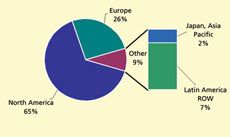Laboratory Information Management Systems
Today's laboratories are sophisticated, generate large amounts of data and rely on electronic data collection and tracking via a laboratory information management system (LIMS).
Today's laboratories are sophisticated, generate large amounts of data and rely on electronic data collection and tracking via a laboratory information management system (LIMS).

Regional distribution of LIMS survey respondents. A LIMS allows a laboratory to manage both logistic and analytical data, along with having the ability to interface with corporate reporting software, instruments and a host of other software modules. The LIMS has become a necessity for both small and large companies to allow its users to obtain, store, manage, retrieve and report laboratory data. LIMS products in the market vary widely in cost, sophistication and industrial focus.
Companies can opt to design a LIMS to suit their exact needs with respect to their internal processes, instruments and general operation from the ground up. However, this all comes at a premium. Instead, many companies are abandoning their in-house developed LIMS for commercial systems.
While vendors offer generic LIMS packages that can be customized for any lab, LIMS vendors also are offering “off-the-shelf” solutions, which address vertical markets by integrating more functionality into the core software. Because off-the-shelf products are designed for a particular industry, lab function and application, users do not need to spend as much time customizing the LIMS. This means users can begin to utilize the LIMS quicker.
In a recent survey from Strategic Directions International, over 650 LIMS users were asked to indicate the top criteria when choosing a LIMS vendor. The most frequently mentioned criteria were customer and technical support, reputation and a company's long-term stability. These criteria have become increasingly important over the years, partly because the magnitude of LIMS installations and the vital role it plays in everyday laboratory decisions.
The accompanying graph shows the regional distribution of respondents to the survey. North America represented the largest segment of respondents. Europe and Japan/Asia Pacific combined for 28% of the respondents, while the Latin America and the rest-of-world accounted for 7%.
The foregoing data was extracted from SDi's Tactical Sales and Marketing (TSM) report entitled: Labs on LIMS 2007. Contact Glenn Cudiamat, VP of Research Services, Strategic Directions International, Inc., 6242 Westchester Parkway, Suite 100, Los Angeles, CA 90045; tel. (310) 641-4982, fax (310) 641-8851, e-mail: cudiamat@strategic-directions.com.
Altering Capillary Gas Chromatography Systems Using Silicon Pneumatic Microvalves
May 5th 2025Many multi-column gas chromatography systems use two-position multi-port switching valves, which can suffer from delays in valve switching. Shimadzu researchers aimed to create a new sampling and switching module for these systems.
Studying Cyclodextrins with UHPLC-MS/MS
May 5th 2025Saba Aslani from the University of Texas at Arlington spoke to LCGC International about a collaborative project with Northwestern University, the University of Hong Kong, and BioTools, Inc., investigating mirror-image cyclodextrins using ultra-high performance liquid chromatography–tandem mass spectrometry (UHPLC–MS/MS) and vibrational circular dichroism (VCD).

.png&w=3840&q=75)

.png&w=3840&q=75)



.png&w=3840&q=75)



.png&w=3840&q=75)







